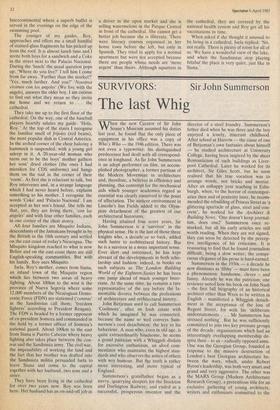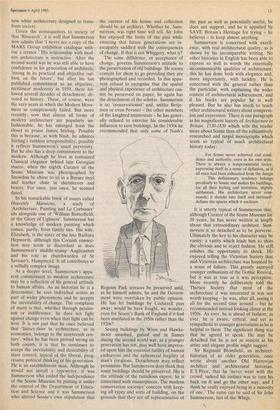The last Whig
When the new Curator of Sir John Soane's Museum assumed his duties last year, he found that the only piece of equipment in his office was a copy of Who's Who — the 1946 edition. There was not even a typewriter: his distinguished predecessor had dealt with all correspond- ence in longhand. As Sir John Summerson is an adept performer on film, an accom- plished photographer, a former partisan of the Modern Movement in architecture and, therefore, a believer in efficiency and planning, this contempt for the mechanical aids which younger academics regard as essential was clearly contrived to the point of affectation. The austere environment in Lincoln's Inn Fields added to the Olym- pian detachment of the greatest of our architectural historians.
Having attained four score years, Sir John Summerson is a 'survivor' in the physical sense. He is the last of those three knights who, a decade or so back, added such lustre to architectural history. But he is a survivor in a more important sense. Ever alert and interested, he has kept abreast of the developments in both scho- larship and fashion: indeed, in books on such subjects as The London Building World of the Eighteen-Sixties he has been one jump ahead of much younger histo- rians. At the same time, he remains a rare representative' of the era before the la- mentable divorce between the professions of architecture and architectural history.
John Betjeman used to call Summerson 'Coolmore', after an Irish estate with which he imagined he was connected, because the name so well conveys Sum- merson's cool detachment: the key to his behaviour. A man who, even in old age, is quite extraordinarily handsome, he seems a grand patrician with a Whiggish disdain for excessive enthusiasm, an aloof com- mentator who maintains the highest stan- dards and who observes the antics of others with wry humour. But the truth is rather more interesting, and more typical of England.
Summerson's grandfather began as a navvy, quarrying sleepers for the Stockton and Darlington Railway, and ended as a successful, prosperous inventor and the
director of a steel foundry. Summerson's father died when he was three and the boy enjoyed a lonely, itinerant childhood. After school at Harrow — the cause of one of Betjeman's own fantasies about himself — he studied architecture at University College, having been inspired by the sheer Romanticism of such buildings as Liver- pool Cathedral. Later he worked for its architect, Sir Giles Scott, but he soon realised that his true vocation was to arrange words, not bricks and mortar. After an unhappy year teaching in Edin- burgh, when, to the horror of contempor- aries then and of posterity later, he recom- mended the rebuilding of Princes Street as 'a glittering spectacle of glass, steel and con- crete', he worked for the Architect & Building News. 'One doesn't keep journal- ism, does one;' Summerson once re- marked, but all his early articles are still worth reading. When they are not signed, they can soon be detected by the percep- tive intelligence of his criticisms. It is reassuring to find that he found journalism difficult, being a slow writer; the conspi- cuous elegance of his prose is hard-earned.
Summerson in the 1930s — a decade he now dismisses as 'filthy' — must have been a phenomenon: handsome, clever – and funny. Already he was the patrician; one reviewer noted how his book on John Nash – the first full biography of an historical architect other than Wren to be written in English – manifested a Whiggish detach- ment in the acceptance of the loss of Regent Street, for with his 'deliberate understatements . , Mr Summerson has stressed nothing'. But he was sufficiently committed to join two key pressure groups of the decade: organisations which had an interestingly overlapping membership de- spite their – to us – radically opposed aims. One was the Georgian Group, founded in response to the massive destruction of London's best Georgian architecture be- tween the wars, which, under Robert Byron's leadership, was both very smart and grand and very aggressive. The other was the MARS Group (Modern Architecture Research Group), a pretentious title for an exclusive gathering of young architects, writers and enthusiasts committed to the
new white architecture designed to trans- form society.
Given the consequences to society of that 'Research', it is well that Summerson now admits that 'I never see a copy of the MARS Group exhibition catalogue with- out a tremor.' His relationship with mod- ern architecture is instructive. After the second world war he was still able to have confidence in his generation of architects, 'strong in its practical and objective out- look on the future', but after his last published . commitment to an objective, rectilinear modernity in 1959, there fol- lowed several decades of detachment, de-
voted to history. These, of course, were
the very years in which the Modern Move- ment so conspicuously failed. But more recently, now that almost all forms of modern architecture are popularly un- fashionable, he has emerged from the closet to praise James Stirling. Possibly this is because, as with Nash, he admires Stirling's ruthless irresponsibility; possibly it reflects Summerson's usual perversity.
But he also has a deep commitment to the modern. Although he lives in restrained Classical elegance behind late Georgian stucco, when the eighth Curator of the Soane Museum was photographed by Snowdon he chose to sit in a Breuer steel and leather chair in shirtsleeves and braces. For once, just once, he seemed dated.
In his remarkable book of essays called Heavenly Mansions, a study of
'Architecture, Painting and Le Corbusier' sits alongside one of 'William Butterfield, or the Glory of Ugliness'. Summerson has a knowledge of modern painting which comes, partly, from family ties. His wife, Elizabeth, is the sister of the late Barbara Hepworth, although this Cornish connec- tion may seem as discordant as does Summerson's middle-stump Anglicanism and his role as churchwarden of St Saviour's, Hampstead. It all contributes to a wilfully complex image.
At a deeper level, Summerson's appa- rent commitment to modern architecture may be a reflection of his general attitude to human affairs. As an historian he is a determinist; he sees individual artists as part of wider phenomena and he accepts the inevitability of change. The complaint of many is that, whether through pessim- ism or indifference, he does not fight against change even when that fight can be won. It is not just that he once believed
that 'laissez-faire in architecture, as in
economics, belongs to the nineteenth cen- tury', when he has been proved wrong on both counts; it is that he continues to accept the inevitability and desirability of state control, typical of the liberal, prog- ressive political thinking of his generation.
He is an establishment man. Although he
would not install a typewriter, it was Summerson Who ended the independence
of the Soane Museum by putting it under the control of the Department of Educa- tion and Science and it was Summerson who altered Soane's own stipulation that the curator of his house and collection should be an architect. Whether he, Sum- merson, was right time will tell. Sir John has enjoyed the fruits of the past while ensuring that future generations are in- escapably saddled with the consequences of change. If that is not Whiggery, what is?
The same diffidence, or acceptance of change, governs Summerson's attitude to the preservation of old buildings. He seems content for them to go providing they are photographed and recorded. In this appa- rent refusal to recognise that the spatial and physical experience of architecture can- not be preserved on paper, he again has the detachment of the scholar. Summerson is no 'conservationist' and, unlike Betje- men or even Pevsner — the other members of the knighted triumvirate — he has gener- ally refused to exercise his considerable influence to save buildings. In the 1950s he recommended that only some of Nash's
Regents Park terraces be preserved until, as he himself admits, he and the Govern- ment were overtaken by public opinion. He has let buildings by Cockerell pass away; would he have fought, we wonder, even for Soane's Bank of England if it had been mutilated in the 1950s rather than the 1920s?
Seeing buildings by Wren and Hawks- moor smashed, gutted and in flames during the second world war, as a younger generation has not, may well have impress- ed upon him the essential futility of human endeavour and the ephemeral fragility of man's creations. Detachment may reflect pessimism. But Summerson does think that some buildings should be preserved. His is the attitude of the fastidious expert; he is concerned ,with masterpieces. The modern conservation societies' concern with keep- ing all types and sorts of building, on the grounds that they are all representative of the past as well as potentially useful, he does not support, and he is appalled by SAVE Britain's Heritage for trying — he believes — to keep almost anything.
Summerson is concerned with excell- ence, with real architectural quality, as is shown by his incomparable writing. No other historian in English has been able to express so well in words the essentially incommunicable qualities of architecture; this he has done both with elegance and, more importantly, with lucidity. He is concerned with the general rather than the particular, with explaining the wider context of architectural achievement, and if his books are popular he is well pleased. But he also has much to teach other architectural writers about compress- ion and expression. There is one paragraph in his magnificent history of Architecture in Britain: 1530-1830 which tells the reader more about Soane than all the exhaustively researched and turgid monographs which seem so typical of much architectural history today: . . . For Soane never achieved real confi- dence and authority, even in his own style. There is always a temperamental factor, expressing itself in a sense of deflation, as if all mass had been exhausted from the design . . . This deflationary tendency belongs peculiarly to Soane and makes his buildings, for all their feeling and invention, slightly subhuman. His architecture never com- mands; it shrinks into itself and nervousl∎ defines the spaces which it encloses.
It is utterly typical of Summerson that, although Curator of the Soane Museum for 39 years, he has never written at length about that extraordinary architect. Sum- merson is so detached as to be perverse. Ultimately the key to his character may be vanity: a vanity which leads him to shun the obvious and to reject fashion. He still relishes the opportunity to shock. He enjoyed telling the Victorian Society that mid-Victorian architecture was haunted by a sense of failure. This greatly annoyed' younger enthusiasts of the Gothic Revival, but it was as true as it was perceptive. More recently he deliberately told the Thirties Society that most of the architecture it was interested in was not worth keeping — he was, after all, seeing it all for the second time around — but he recommended instead looking closer at the 1950s. As ever, he is ahead of fashion; as ever, he is aware, critical, and yet as sympathetic to younger generations as he is helpful to them. The significant thing was that he agreed to speak. He may be detached but he is not as remote as his attire and elegant profile might suggest.
Sir Reginald Blomfield, an architect- historian of an older generation, once wrote about another Old Harrovian architect and architectural historian, E.S.Prior, that he 'never went with the crowd, indeed his instinct was to turn his back on it and go the other way, and I think he really enjoyed being in a minority of one.' The same can be said of Sir John Summerson, last of the Whigs.











































 Previous page
Previous page